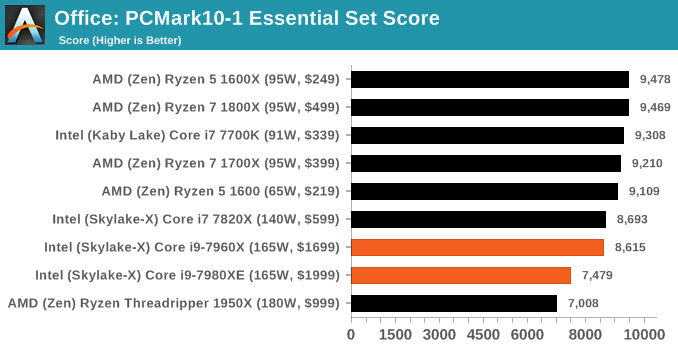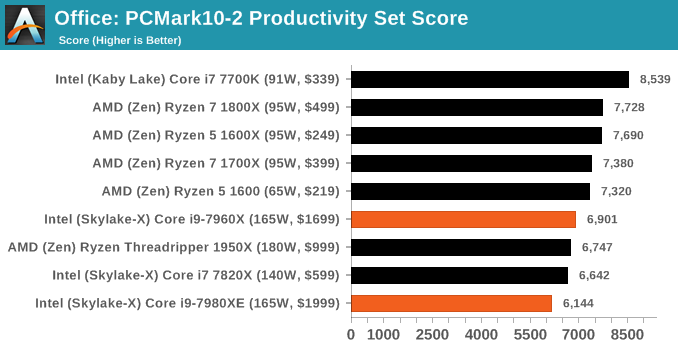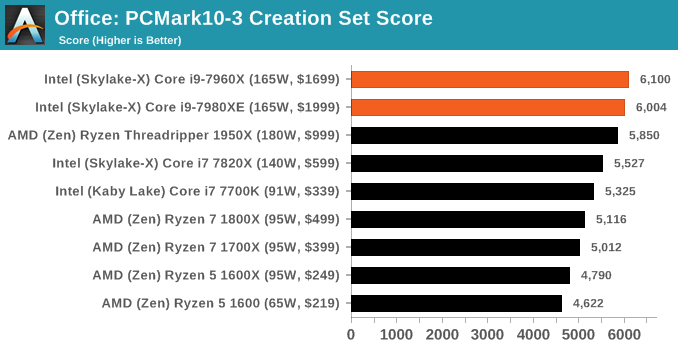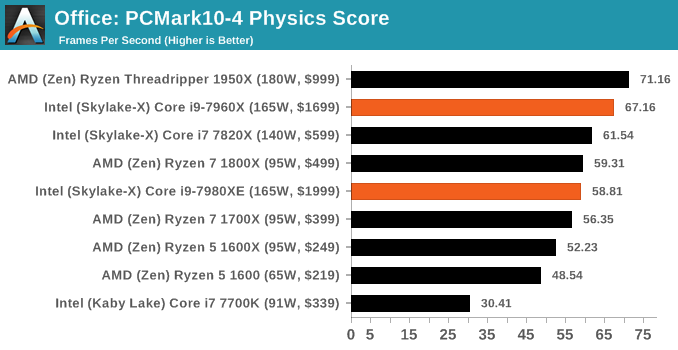The Intel Core i9-7980XE and Core i9-7960X CPU Review Part 1: Workstation
by Ian Cutress on September 25, 2017 3:01 AM ESTBenchmarking Performance: PCMark 10
PCMark 10 is the 2017 update to the family favorite, PCMark 8. PCMark 8 has been part of our test bed since the latest update in Q1. For the most part it runs well, although for some processors it doesn’t recognize, some tests will not complete, leading to holes in our benchmark data (there’s also an odd directory quirk in one test that causes issues). The newest version, PCMark 10, is the answer.
The new test is adapted for more 2016/2017 workflows. With the advent of office applications that perform deeper compute tasks, or the wave of online gamers and streamers, the idea behind PCMark 10 is to give a better ‘single number’ result that can provide a comparable metric between systems. Single metrics never tell the whole story, so we’re glad that Futuremark provides a very detailed breakdown of what goes on.
Ganesh’s article on PCMark 10 goes into more detail than I will here, but the ‘Extended Benchmark’ runs through four different sets of tests: Essential, Productivity, Creation and Gaming. Each of these have sub-test results as well, including startup performance, web performance, video conferencing, photo/video editing, spreadsheets, rendering, and physics, which you can find in Bench.














152 Comments
View All Comments
CrazyHawk - Tuesday, September 26, 2017 - link
"Intel also launched Xeon-W processors in the last couple of weeks."Just where can one purchase these mythical Xeon-W processors? There hasn't been a single peep about them since the "launch" week. I've only heard of two motherboards that will support them. They seem to be total vaporware. On Intel's own site, it says they were "Launched" in 3Q2017. Intel had better hurry up, 3Q will be up in 4 days!
samer1970 - Tuesday, September 26, 2017 - link
I dont understand why intel disables ECC on their i9 CPU , they are losing low budget workstation buyers who will 100% choose AMD threadripper over intel i9..Even if they are doing this to protect their xeons chips ,they can enable non buffered ECC and not allow Registered ECC on the i9 problem solved. unbuffered ECC has Size limitation and people who want more RAM will go for xeons.
Remember that their i3 has ECC support , but only the i3 ...
intel , you are stupid.
vladx - Wednesday, September 27, 2017 - link
Newsflash, these chips don't target "low budget workstation buyers". Golden rule is always: "If you can't afford it, you're not the target customer.".samer1970 - Wednesday, September 27, 2017 - link
Thats not a Golden Rule anymore with the Threadripper chips around . it is called "Stupid rule" ...They are allowing AMD to steal the low budget workstation buyers by not offering them an alternative to choose from.
vladx - Wednesday, September 27, 2017 - link
The "low budget workstation buyers" as you call them are a really insignificant percentage of an already really small piece of the huge pie of Intel customers.samer1970 - Wednesday, September 27, 2017 - link
who told you so ? Most engineering students at universities need one , and Art Students who render alot as well. all these people will buy threadripper CPU and avoid intel , for intel xeon are 50% more expensive .andI dont cae about the percentage in intel Pie ... hundreds of thousands student enter uiviersites around the world each year . Low percentage or not they are alot ...
how much do you think a low budget workstation costs ? they start from $3000 ... and with xeon Pricing , it will be very difficult to add alot of RAM and a good workstation card and fast SSD .
esi - Wednesday, September 27, 2017 - link
What's the explanation for some of the low scores of the 7980XE on the SPECwpc benchmarks? Particularly Poisson, where the 6950X is 3.5X higher.ZeDestructor - Wednesday, September 27, 2017 - link
Most likely cache-relatedesi - Wednesday, September 27, 2017 - link
Maybe. But one that really makes no sense is the Dolphin 5.0 render test. How can the 7980XE take nearly twice as long as the 7960X?esi - Wednesday, September 27, 2017 - link
So I ran the Poisson benchmark on by 6950X. It uses all 10 cores (20 h/w threads), but can be configured to run in different ways: you can set the number of s/w threads per process. It then creates enough processes to ensure there's one s/w thread per h/w thread. Changing the s/w threads per processes significantly effects the result:20 - 1.34
10 - 2.5
5 - 3.31
4 - 3.47
2 - 3.67
1 - 0.19
Each process only uses about 2.5MB of RAM. So the 1-thread per process probably has a low result as this will result in more RAM usage than L3 cache, whereas the others should all fit in.
Would be interesting to see what was used for the 7980/7960. Perhaps the unusual number of cores resulted in a less than optimal process/thread mapping.